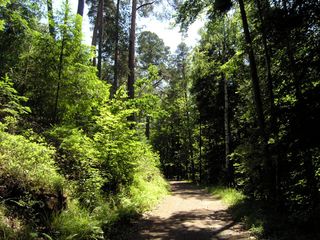The Lost Forests of America

You could plant any old tree to celebrate Arbor Day April 24. But consider instead a sugar maple, or another of the native trees that once abounded in this country.
The forests that once dominated this nation were full of trees such as chestnuts, hemlocks and white pines on the East Coast and conifers such as redwoods and Douglas firs on the West Coast.
Around the arrival of Columbus, "it's said that squirrels could travel from tree to tree from the Northeast to the Mississippi without ever having to touch the ground," said Chris Roddick, chief arborist at the Brooklyn Botanic Garden in New York. "In the old growth forests in the Northeast, you had hemlock that were six or seven feet in diameter, chestnut trees 200 feet tall."
Although Native Americans used to burn forests to farm, such practices were nowhere close to damaging "as the drastic deforestation that came with the Europeans," Roddick said. The colonists, like the Native Americans, cleared forests to farm, and felled trees for their timbers as well. "White pine was used a lot for shipbuilding," he explained.
While some pockets of old growth remain, supporting trees that are hundreds of years old, the majority of those ancient forests have been replaced by younger trees that are much smaller and typically grow in settings that look nothing like bygone forests.
As deforestation leveled native trees, so too have infestations of disease and insects decimated forests:
- A fungal disease called chestnut blight attacked the American chestnut.
- A sap-sucking relative of the aphid from East Asia known as the hemlock woolly adelgid helped drive hemlocks into decline.
- Dutch elm disease devastated American elms.
- The emerald ash borer has killed millions of ash trees.
- The fungus-like organism that causes sudden oak death is threatening oaks.
- The Asian longhorn beetle has been attacking maple trees, "and if it were to get at sugar maples in New England, that would be very disastrous," Roddick said.
Invasive species were introduced as well, either trees grown for timber or as ornaments that escaped into the wild. "The Norway maple is pretty common in New York City and New England, and that's a European native," Roddick said. "One mature tree can have hundreds of thousands of seeds on it and out-compete native forests."
Sign up for the Live Science daily newsletter now
Get the world’s most fascinating discoveries delivered straight to your inbox.
Global warming is also affecting forests. "The sugar maple is an American native that needs cooler weather, and we're seeing it move to northern latitudes and higher elevations, which is thought in part due to climate change," Roddick said. "It's not clear what changes might happen with trees due to climate change — it might affect how much rain we get, and some species might flower earlier, but if their pollinators aren't out yet, it's not clear what effects that might have."
The native species of trees people might want to plant on Arbor Day depend on which region you are in.
"The best thing to do is to contact a state cooperative extension, which usually can tell you which trees are best for different soil types or for sunny or shady areas, but I think what we really need is to replace the big shady canopy trees," Roddick said. "These are going to live longer and sequester more carbon. Think of sugar maples and oaks."
Trees are vital "because they do about half the photosynthesis on Earth, and they help sequester tremendous amounts of carbon," Roddick said. But they are also important because "they can provide shade that can cool houses and save on energy bills, as well as filter the air of pollution, and having well-maintained trees can improve the value of homes substantially."
- Earth Checkup: 10 Health Status Signs
- U.S. Forests Getting 'Loved to Death'
- More News About Forests

Most Popular


